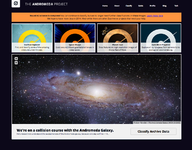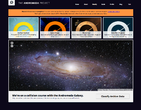Andromeda Project: Difference between revisions
Jump to navigation
Jump to search
mNo edit summary |
mNo edit summary |
||
| (3 intermediate revisions by 2 users not shown) | |||
| Line 3: | Line 3: | ||
|field_project_access_URL=https://www.zooniverse.org/project/andromedaproject | |field_project_access_URL=https://www.zooniverse.org/project/andromedaproject | ||
|field_screenshot=Capture d’écran 2013-11-14 à 15.17.15.png | |field_screenshot=Capture d’écran 2013-11-14 à 15.17.15.png | ||
|field_project_open= | |field_infrastructure=Zooniverse | ||
|field_project_start_date=2012/12/04 | |||
|field_project_end_date=2013/12/05 | |||
|field_project_open=No | |||
|field_subject_areas=Natural sciences | |field_subject_areas=Natural sciences | ||
|field_cs_subject_areas=space | |field_cs_subject_areas=space | ||
| Line 14: | Line 17: | ||
After you help us to find these star clusters, we will use several techniques to determine the age and mass of these objects. In some clusters, we can resolve individual stars that allow us to determine the age, mass, and other aspects of the object. In other clusters, where individual stars are too faint or too close together, we can use the summed light from a cluster to determine its properties (Fouesneau+ 2012, in prep.). With these ages and masses in hand, we can use these clusters to study a host of interesting topics: rapid and rare stages of stellar evolution, the structure and scale of star formation, the evolution of cluster populations, and how Andromeda has changed over billions of years. | After you help us to find these star clusters, we will use several techniques to determine the age and mass of these objects. In some clusters, we can resolve individual stars that allow us to determine the age, mass, and other aspects of the object. In other clusters, where individual stars are too faint or too close together, we can use the summed light from a cluster to determine its properties (Fouesneau+ 2012, in prep.). With these ages and masses in hand, we can use these clusters to study a host of interesting topics: rapid and rare stages of stellar evolution, the structure and scale of star formation, the evolution of cluster populations, and how Andromeda has changed over billions of years. | ||
|field_location_of_activities=International | |||
|field_team_leadermm=Julianne Dalcanton | |field_team_leadermm=Julianne Dalcanton | ||
|field_main_institution=University of Washington | |field_main_institution=University of Washington | ||
|field_partner_institutions=Adler Planetarium, GLObal Robotic-telescopes Intelligent Array, Panchromatic Hubble Andromeda Treasury, Hubble, Zooniverse | |field_partner_institutions=Adler Planetarium, GLObal Robotic-telescopes Intelligent Array, Panchromatic Hubble Andromeda Treasury, Hubble, Zooniverse | ||
|field_team_link=http://www.andromedaproject.org/#!/about/people/science-team | |field_team_link=http://www.andromedaproject.org/#!/about/people/science-team | ||
|field_contact_person_URLs=http://talk.andromedaproject.org/ | |field_contact_person=Not explicitely specified | ||
|field_contact_person_URLs=http://talk.andromedaproject.org/ or https://twitter.com/andromedaproj | |||
|field_team_location=University of Washington | |field_team_location=University of Washington | ||
|field_participant_task_description=Mark interesting features with circles and crosses. | |field_participant_task_description=Mark interesting features with circles and crosses. | ||
|field_Haklay_typology=distributed intelligence | |||
|field_volonteer_computing=no | |field_volonteer_computing=no | ||
|field_volonteer_thinking= | |field_volonteer_thinking=yes | ||
|field_volonteer_sensing=no | |field_volonteer_sensing=no | ||
|field_volonteer_gaming=no | |field_volonteer_gaming=no | ||
|field_data_types_to_manipulate=pictures | |field_data_types_to_manipulate=pictures | ||
|field_participant_contribution_type=data analysis, data interpretation | |field_participant_contribution_type=data analysis, data interpretation | ||
|field_interface_attractivity=cool/attractive | |field_gaming_genre=puzzle | ||
|field_interface_usability= | |field_interaction_with_objects=Users must identify star clusters in photographs taken of the Andromeda galaxy. | ||
|field_tutorials_documentation= | |field_interface_attractivity=somewhat cool/attractive | ||
|field_interface_usability=somewhat difficult to use | |||
|field_tutorials_documentation=somewhat | |||
|field_peer_to_peer_guidance=no | |field_peer_to_peer_guidance=no | ||
|field_training_sequence=no | |field_training_sequence=no | ||
|field_individual_performance_feedback=N/A | |field_individual_performance_feedback=N/A | ||
|field_collective_performance_feedback= | |field_collective_performance_feedback=yes | ||
|field_research_progress_feedback=N/A | |field_research_progress_feedback=N/A | ||
|field_member_profiles= | |field_member_profiles=minimal | ||
|field_community_tools=website, blog, forum | |field_member_profile_elements=other | ||
|field_has_community_manager= | |field_community_tools=website, blog, forum, chat | ||
|field_project_news_updates= | |field_has_community_manager=maybe | ||
|field_socialsoftware_sites=Twitter | |field_project_news_updates=weekly | ||
|field_team_work= | |field_project_news_site=http://talk.andromedaproject.org/chat | ||
|field_completion_level= | |field_socialsoftware_sites=Twitter, Facebook | ||
|field_last_edition=2013/ | |field_events_frequency=0 | ||
|field_community_roles=Forum participation and community problem solving/discussion | |||
|field_community_interaction_forms=Forum chat | |||
|field_team_work=no | |||
|field_community_awareness_tools=Twitter and Zooniverse AMA on reddit | |||
|field_community_led_additions=n/a | |||
|field_completion_level=High | |||
|field_last_edition=2013/12/20 | |||
}} | }} | ||
Project has been retired, with some hopes of new data for 2014 to resurrect it. Project is very active and successful when where is new data to classify, but otherwise quiet. | |||
{{Free text}} | {{Free text}} | ||
Latest revision as of 13:06, 15 April 2015
Project has been retired, with some hopes of new data for 2014 to resurrect it. Project is very active and successful when where is new data to classify, but otherwise quiet.
| BIBLIOGRAPHY |



